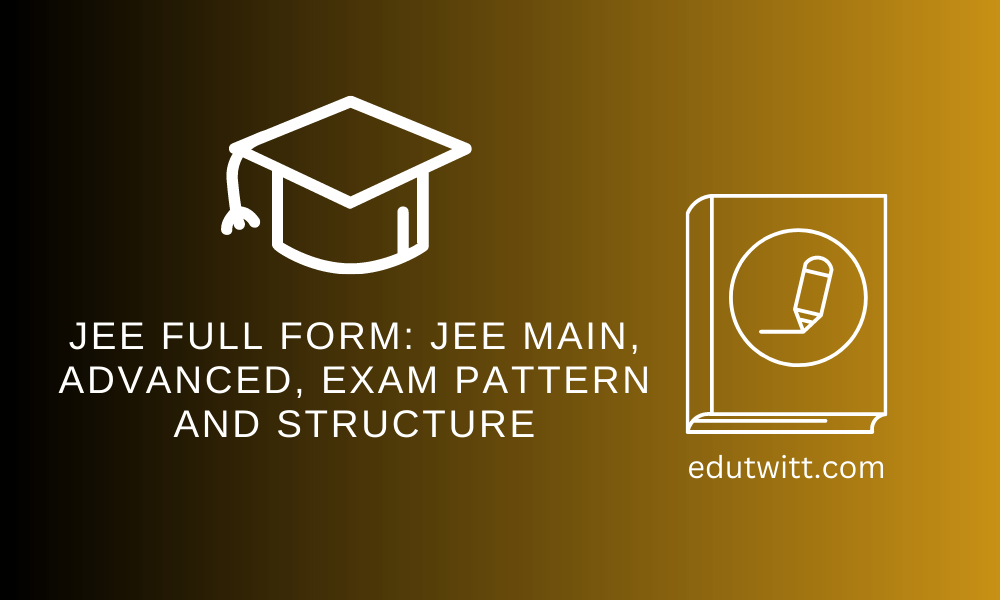
Common Entrance Examination( JEE) is an engineering entrance assessment conducted for admission to colorful engineering sodalities in India. It’s constituted by two separate examinations JEE Main and JEE Advanced.
common Seat Allocation Authority( JoSAA) conducts the common admission process for a aggregate of 23 Indian Institute of Technology premises , 31 National Institute of Technology premises , 25 Indian Institute of Information Technology premises , and 19 other Government Funded Technical Institutes( GFTIs) grounded. On the rank attained by a pupil in JEE Main and JEE Advanced.
JEE Full Form
The full form of JEE is common Entrance Examination. JEE is called Joint Entrance Examination in Hindi. JEE is an entrance test that one has to clear to get admission in NITs, IITs, CFTI sodalities. JEE is an entrance test that’s a means of admission in numerous engineering sodalities in India. Without clearing JEE entrance test you can not take admission to any engineering council in India. JEE test is conducted in two corridor, JEE Main and Advanced.
JEE Main
National Testing Agency( NTA) is conducting JEE Main. JEE Main consists of two papers, Paper- I and Paper- II. campaigners can choose any one or both of them. Both the papers have multiple- choice questions. Paper- I is for admission toB.E./B.Tech courses and is conducted in Computer Grounded Test Mode. Paper- II is for admission toB.Arch andB.Planning courses and will also be conducted in computer- grounded test mode except for one paper, videlicet ‘ Drawing Test ’, which will be conducted in pen and paper mode or offline mode. Will go An fresh paper- III is being introduced independently forB.Planning courses from January 2020.
Due to the COVID- 19 epidemic in 2020, there has been a change in the paper format and number of attempts in JEE Main 2021. Now there will be 20 single choice questions and 10 numerical questions out of which only five numerical questions are to be tried. The marking scheme is the same as before i.e. for SCQs, 4 marks for correct answer and-1 mark for a wrong answer and 0 marks for not answered, and for numerical type questions, 4 marks for correct and 0 marks for wrong.
JEE Main, unlike JEE Advanced, has a fixed test structure and isn’t subject to change every time. As of 2018, JEE test Paper- 1 is of three hours duration and consists of thirty single choice questions in each of the three subjects( Physics, Chemistry, and Mathematics). 4 marks are awarded for correct answers and 1 mark is subtracted for wrong answers. The scholars who take this test are generally in the age group of 18- 20 times.
A new pattern conforming of 20 5 questions per subject was introduced by NTA in January 2020 with 20 single choice questions 5 numerical type questions. 4 marks are awarded for correct answers in single- choice questions and no marks are subtracted for numerical type questions.
From 2013 to 2016, marks attained in Class XII academy board examinations were given 40 weightage in deciding JEE Main All India Rank.
JEE Advanced
JEE Advanced test is conducted for admission to 23 IITs and some other prestigious universities like IISc Bangalore, IIST Thiruvananthapuram, etc. This test is conducted every time by one of the IITs. The test in 2020 was conducted by IIT Delhi. It’ll be conducted by IIT Kharagpur, IIT Bombay and IIT Guwahati in 2021, 2022, 2023 independently.
Every time more than 2 lakh scholars qualify to write in JEE Advanced. scholars who qualify JEE- Main test come eligible for the JEE- Advanced test. In 2018, 224,000 scholars were allowed to take JEE- Advanced, a number that stood at 220,000 in 2017 and 200,000 in 2016.
What’s The significance of The JEE test?
Every time lakhs of scholars clear the 10 2 examinations and also aspire to get admission in reputed institutes. Now institutes conduct this test to elect only cream scholars. piecemeal from this, scholars also start preparing to qualify for JEE, and this automatically raises the position of the scholars. The main reason for this test is to elect the stylish scholars from the rest.
JEE test Pattern
JEE Main test is especially for those scholars who want to take admission in the top National Institute of Technology, Indian Institute of Information Technology in courses like BE and BTech.However, also you have to appear in JEE Advanced, If you further clear JEE Main test. If you give both these examinations also you’ll get a chance to study at IIT.
JEE Main test consists of Paper 1 and Paper 2. Paper 1 is for the scholars who want to take admission in BE andB.Tech courses, in discrepancy, paper 2 is for the scholars ofB.Planning andB.Arch courses. campaigners have to specify the papers they want to appear. They’ve to specify whether they want to appear in both the papers or not.
Structure of JEE examination
- JEE is made up of two examinations; JEE Main and JEE Advanced. JEE Advanced test is considered to be one of the toughest entrance examinations for the undergraduate position.
- JEE Main is the eligibility test that allows aspirants to appear in JEE Advanced test and ultimately leads to registration in NITs, IITs,etc.
- JEE Main test is conducted twice a time and the number of admission attempts in a specific academic session is considered as one. aspirants can elect one paper or both. This is done online.
- The duration of the test is three hours, conforming of three papers. Paper( 1) consists of 30 MCQs( Multiple Choice Questions) from Physics, Chemistry, and Mathematics. For the wrong answer, there’s one negative mark.
- Paper 1 is for BE andB.Tech registration, Paper 2 is forB.Arch registration, and Paper 3 is forB.Planning courses.
- aspirants can appear for JEE Main test for three successive times but can appear for JEE Advanced test only for two successive times.
- Passing Marks for General order – 81, for OBC- 49, for SC – 32, ST – 27, and for PWD – 1.
- The cut-off score for JEE Main is decided by the test conducting NTA( National Testing Agency) and varies on the base of orders like General, OBC, SC and ST, and PWD.
